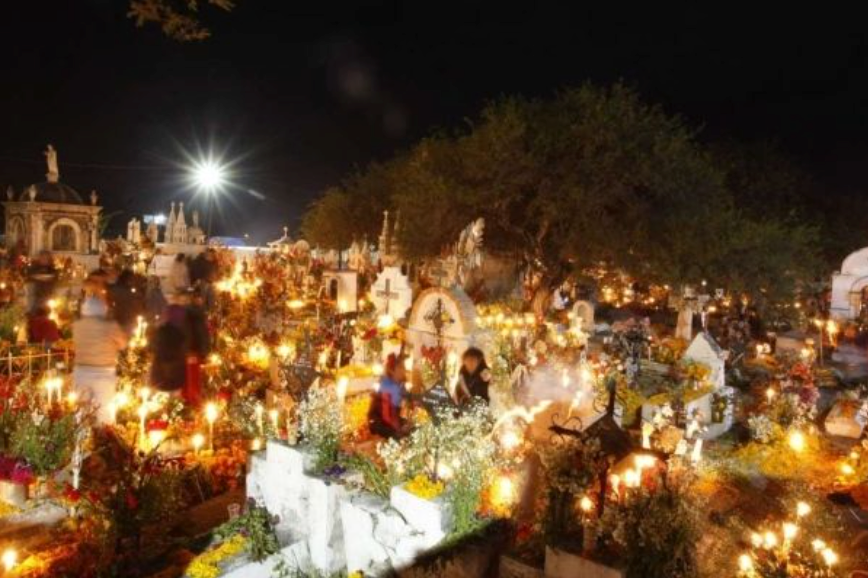
A Colorful Look into Dia de los Muertos
A Colorful Look into Día de los Muertos written by Morgan Watkins
Known far and wide as the Day of the Dead, Día de los Muertos celebrates death with joyous festivities, ceremonies at cemeteries, and tasty treats. It is a series of days that birthed not only a new way of understanding and appreciating death, but also vibrantly vivid fashion looks and glorious face painting masterpieces. But how did these styles and beauty looks come to fruition in the first place? And how has this holiday withstood the test of time? Read on to dive into the past and promising future of Día de los Muertos!

(Image from https://www.rebelsmarket.com/blog/posts/dia-de-los-muertos-the-history-and-fashion-of- day-of-the-dead)
Dating back a whopping 3,000 years, the Day of the Dead was initially a combination of Aztec ritual mixed with Catholicism. The holiday lasts from October 31st through November 2nd, celebrating the souls of loved ones who have passed. The souls of deceased children are said to come down from heaven on November 1st, while those of adults who’ve passed visit on the 2nd. While most cultures weep over the death of loved ones, the great Aztecs saw mourning as disrespectful towards the dead. Even when individuals would pass, they were still considered members of the community in Mexican cultures, and in that spirit, their souls would be celebrated instead of grieved over.

(Image from https://www.cnn.com/2015/10/29/living/dia-de-los-muertos-makeup-tradition-feat-irpt/ind ex.html)
On these days, families welcome close knit communities into their homes to chow down on some delicious eats around handmade altars, which are dedicated to lost loved ones. These altars are often decorated to the nines with a lovely assortment of flowers, lit candles, and colorful papel picado, or designs and murals sliced neatly into thin, tissue-like paper. Pan de muerto,or “the bread of the dead,” is also passed about before celebrating parties take to the cemetery to carry on with the festivities. Once there, friends and family enjoy each other's company while performing activities that the deceased enjoyed partaking in before their passings.

(Image from http://saintelizabethchurch.org/all-souls-altar-del-dia-de-los-muertos-mexico/)
Commonly associated with Día de los Muertos are, of course, the iconic skeletons and skulls, or calacas and calaveras. These symbols of death are characteristically glammed up in fancy suits and flowy dresses, styled exquisitely with bright, intricate designs painted onto the calaveras. The most popular image from Day of the Dead is political cartoonist José Guadalupe Posada’s La Calavera Catrina, a female skeleton whose dazzling skull embellishments are frequently replicated on the faces of those celebrating the occasion. Día de los Muertos’ connection to skeletons and skulls sprouts from the phrase “Todos somos calaveras,” which translates to “We are all skeletons.” This motto takes the frightening edge off of the perception of death as something to be feared and portrays death as a natural part of life, and no matter who you are or what you may or may not have, we are all the same when we meet death.

(Image from https://www.youtube.com/watch?v=lBnnI_NeaQo)
The Day of the Dead’s classic attire is just as extravagant and lively as the holiday’s festivities. Brightly hued suits and eye catching gowns are staple styles for those celebrating the occasion. These fancy silhouettes are paired with lace shawls, flower crowns and noise makers like shells, which are used to electrify crowds and rouse the dead. Face painting is a go-to fashion statement as well, and often mimics the beautifully designed face of La Calavera Catrina.

(Image fromhttp://museumca.org/event/20th-anniversary-days-dead-community-celebration)
Today, Día de los Muertos is widely celebrated all over the world in a myriad of ways. It’s not to be mistaken as some sort of “Mexican Halloween,” but rather appreciated as an occasion of spiritual significance, joy, and deep emotion. So even if you aren’t going all out with a colorful dress or skeletal makeup, be mindful of the beauty of this holiday and the peace it brings to Mexican communities and other individuals across the globe.
References:
Grace, Emily. “Dia De Los Muertos: The History and Fashion of Day of the Dead.” Rebels Market, 29 June 2018, https://www.rebelsmarket.com/blog/posts/dia-de-los-muertos-the-history-and-fashion-of- day-of-the-dead.
Ward, Logan. “Top 10 Things to Know about the Day of the Dead We’ve All Heard about the Day O.” National Geographic, 26 Oct. 2017,
https://www.nationalgeographic.com/travel/destinations/north-america/mexico/top -ten-day-of-dead-mexico/.
